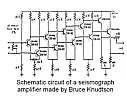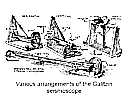part of
Devices for Listening to Sounds Both in Water and in the Solid Earth
seen in "The Amateur Scientist"
by C. L. Stong
August, 1970
from "Scientific American" August 1970
...
 ANOTHER kind of sound that is rarely heard is the sound made be the ringing
earth. Earth vibrations, which range from about 10 cycles per second to several
hours per cycle, are substantially below the minimum frequency to which the
human ear responds (about 16 cycles per second). To hear
earthquakes and similar disturbances one records seismic vibrations
on magnetic tape at the rate of about 3/4 inch of tape per minute and
then reproduces the recording, at the rate of 7.5 inches per second,
speedup of 6oo-fold. A number of interesting sounds are heard on
typical recordings. The most apparent are two wavering sounds, one
slightly above the highest note on the piano and the other close to
middle C. These sounds are made by microseisms: continuous small
tremors of the earth s crest. The seismologist often regards
microseisms as noise that limits the useful sensitivity to which he
can adjust his instruments. The amateur may find microseisms
virtually musical.
ANOTHER kind of sound that is rarely heard is the sound made be the ringing
earth. Earth vibrations, which range from about 10 cycles per second to several
hours per cycle, are substantially below the minimum frequency to which the
human ear responds (about 16 cycles per second). To hear
earthquakes and similar disturbances one records seismic vibrations
on magnetic tape at the rate of about 3/4 inch of tape per minute and
then reproduces the recording, at the rate of 7.5 inches per second,
speedup of 6oo-fold. A number of interesting sounds are heard on
typical recordings. The most apparent are two wavering sounds, one
slightly above the highest note on the piano and the other close to
middle C. These sounds are made by microseisms: continuous small
tremors of the earth s crest. The seismologist often regards
microseisms as noise that limits the useful sensitivity to which he
can adjust his instruments. The amateur may find microseisms
virtually musical.
The higher of the two tones typically arises from our local disturbances: traffic, water running, over a dam, waves breaking against a beach and so on. The intensity of the sound tends to increase during daylight hours in heavily populated areas. The note near or below middle C appears to arise from our a variety of natural causes. Some of the sound has been correlated with cyclonic storms, including barometric "lows," tornadoes and hurricanes. Other contributions have been traced to volcanic activity, the collapse of small natural al caves, rock slides and the impact of meteors.
Of more interest are the sounds of earthquakes. Several earthquakes of significant intensity occur somewhere on the earth every day. An earthquake of special interest is observed almost every week. On the average one earthquake of devastating proportions occur s each year. Minor earthquakes usually make booming sounds that die out within less than a second. Earthquakes of intermediate intensity resemble distant thunder mixed with shot screeches. Big earthquakes may resemble thunder that continues to roll and echo for minutes.
The sound recordings are of little scientific value, either for evaluating, the magnitude of a disturbances or for locating the region where an earthquake has occurred. On the other hand, many amateur seismologists record earth vibrations on photosensitive paper or on long rolls of adding-machine tape. The time and trouble of developing the paper or scanning the tape can be conserved by reproducing in a few minutes a sound tape recorded simultaneously during a period Of 24 hours or more. Indeed, seismograms can be recorded excludively on sound tape. Interesting portions can be subsequently transcribed on paper simply by feeding the output of the tape reproducer at an appropriate speed to a pen recorder.
A convenient seismoscope for generating electrical signals that correspond to earth vibrations was developed in 1906 by B. B. Galitzin, a pfince of Imperial Russia. The device consists of a freely suspended coil of magnet wire, one side of which is located between the poles of a permanent magnet that is anchored to the ground. Earth vibrations displace the magnet with respect to the freely suspended coil. The moving magnetic flux generates electrical signals in the coil. Various ways of suspending the coil have been devised, depending, on the plane in which the vibrations occur. To pick up vibrations in the horizontal plane the coil can be supported at the outer end of a structure resembling a garden gate that swings on low-friction hinges. This arrangement is essentially a pendulum that swings in the horizontal plane at a natural period determined by the mass of the bob and the inclination of the upright support to which the hinges are attached. The more the gate "sags," the faster it swings.
The apparatus is most sensitive to seismic disturbances that correspond in frequency to the natural period of the pendulum. Most seismographs are tuned to a period of 10 seconds, which corresponds in general to the period of the most interesting earthquake wages The pendulum can also be mounted in the horizontal plane and hinged so that it vibrates in the vertical plane. In this arrangement the weight of the coil and the lever arm on which it is mounted are supported by a spring. The signal is generated by the vertical excursions of the magnet. Less popular are seismographs that employ inverted pendulums. The coil is supported at the upper end of a lever arm that rests on a pivot at the lower end. The pendulum is kept from falling, over by springs that exert balancing forces on the four sides of the bob.
 Still another arrangement substitutes a long, rod for the pendulum. One
end of the coil is anchored to the ground; the other end carries
the coil. One side of the coil is immersed in the held of a too permanent
magnet that is
supported by a distant pier also anchored to the ground. Seismic
waves alter the distance between the piers and so displace the coil
with respect to the magnetic field. The weight
of the rod is supported by rollers on top of intermediate piers.
Schematic representations of the four seismoscopes are shown in
the accompanying illustration [above]. Construction details
have been presented in this department (April, 1952, and June, 1953).
Still another arrangement substitutes a long, rod for the pendulum. One
end of the coil is anchored to the ground; the other end carries
the coil. One side of the coil is immersed in the held of a too permanent
magnet that is
supported by a distant pier also anchored to the ground. Seismic
waves alter the distance between the piers and so displace the coil
with respect to the magnetic field. The weight
of the rod is supported by rollers on top of intermediate piers.
Schematic representations of the four seismoscopes are shown in
the accompanying illustration [above]. Construction details
have been presented in this department (April, 1952, and June, 1953).
The amplitude of the relative motion between the magnet and the coil depends on the magnitude of the earthquake and the distance of the instrument from the center of the disturbance. Surface oscillations of more than 20 feet can occur above the center of a violent earthquake. Waves that spread outward from our the center can cause the surface to vibrate more than an inch in 20 seconds at a distance of 1,000 miles. In contrast, the amplitude of microseisms, as then are normally recorded in most U. S. localities, is on the order of millionths of an inch. Although the amplitude of microseisms is small, then generate an adequate signal in a coil of 50,000 turns us in a magnetic field of 3,000 gauss.
...